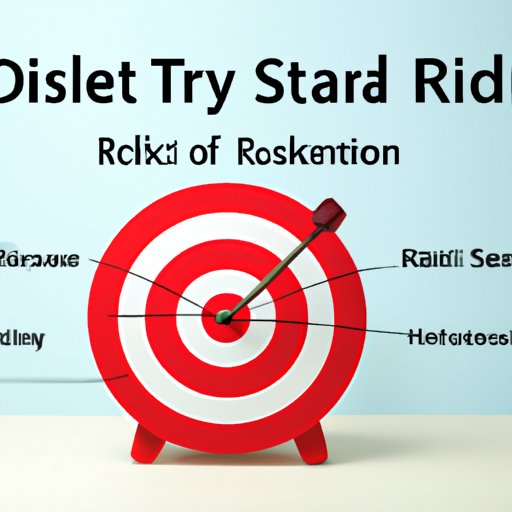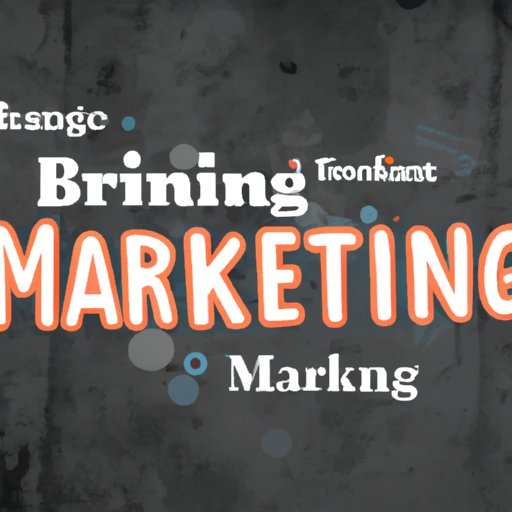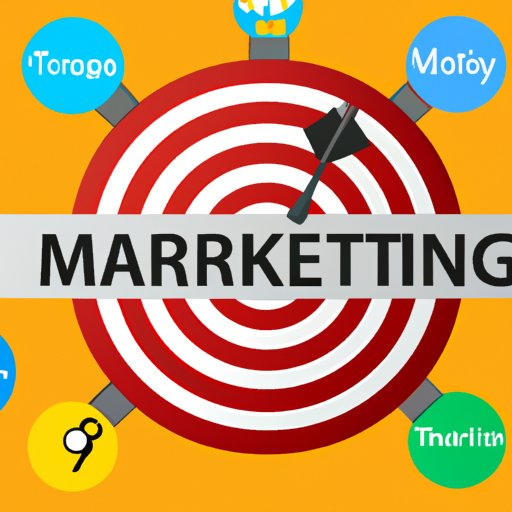Introduction
When creating a business plan, it’s essential to have an in-depth understanding of your target market. Knowing who your customers are, what they need and want, and how you can reach them is key to crafting a successful business plan. With this comprehensive guide, you’ll learn how to identify and define your target market, develop strategies for reaching them, analyze competitors, understand customers, and explore the benefits of targeted marketing.

Identifying Your Target Market: How to Research and Profile Your Ideal Customer
The first step in writing target market for your business plan is to do research and create a profile of your ideal customer. This will help you determine who your target market is and how best to reach them. Here are some tips for researching and profiling your target market:
Researching Demographics
Start by researching the demographics of your target market. Look at factors such as age, gender, income level, education, location, and occupation. This will help you get a better understanding of who your target market is and what they need.
Identifying Customer Needs and Wants
Once you have an idea of who your target market is, you’ll need to identify their needs and wants. What do they need from your product or service? What would make them choose you over your competitors? Understanding your customers’ needs and wants is essential for creating an effective business plan.
Understanding Customer Behaviors
It’s also important to gain an understanding of your target market’s behaviors. How do they shop? Where do they shop? What type of products or services do they buy? What influences their purchasing decisions? Knowing your customers’ behaviors will help you create more effective strategies for reaching them.
Defining Your Target Market: Developing a Focused Strategy
Once you’ve done your research and created a profile of your ideal customer, you’ll need to define your target market. Developing a focused strategy will help you reach the right audience and maximize your results. Here are some tips for defining your target market:
Determining Your Target Market’s Size
First, determine the size of your target market. How many potential customers are there? Knowing the size of your target market will help you develop strategies that are tailored to your specific needs.
Establishing Customer Segments
Next, establish customer segments based on the demographics, needs, and behaviors of your target market. By segmenting your target market, you can create customized strategies for each segment and maximize your reach.
Developing Customer Profiles
Finally, develop customer profiles for each customer segment. These profiles should include detailed information about the demographics, needs, and behaviors of each segment. Having customer profiles will help you create more effective strategies for targeting each segment.

Crafting an Effective Business Plan: How to Incorporate Target Markets
Once you’ve identified and defined your target market, it’s time to craft an effective business plan. Here are some tips for incorporating target markets into your business plan:
Writing Objectives
Start by writing objectives for each customer segment. These objectives should outline the goals you have for each segment and how you plan to reach them. Be sure to include specific, measurable, achievable, relevant, and time-bound (SMART) goals in your objectives.
Outlining Strategies
Next, outline strategies for each customer segment. These strategies should be tailored to the needs and behaviors of each segment and should include details on how you plan to reach them. Be sure to consider factors such as pricing, promotion, distribution, and customer service.
Creating Action Plans
Finally, create action plans for each strategy. These action plans should outline the steps you need to take in order to implement each strategy. Be sure to include tasks, deadlines, and responsible parties in your action plans.
Analyzing Your Competition: Uncovering Your Target Market Opportunities
It’s also important to analyze your competitors when writing target market for your business plan. Analyzing your competitors can help you uncover potential opportunities for reaching your target market. Here are some tips for analyzing your competition:
Assessing Competitors’ Strengths and Weaknesses
Start by assessing your competitors’ strengths and weaknesses. Look at factors such as pricing, promotion, distribution, customer service, and product offerings. This will help you gain an understanding of how your competitors are reaching their target markets and where you may have an opportunity to stand out.
Identifying Potential Opportunities
Once you’ve assessed your competitors’ strengths and weaknesses, you’ll need to identify potential opportunities for reaching your target market. Look for areas where your competitors are not meeting the needs of their target market and look for ways to capitalize on those opportunities.
Exploring How Competitors Are Reaching Customers
Finally, explore how competitors are reaching their customers. What channels are they using? What type of content are they creating? How are they engaging with their customers? Understanding how your competitors are reaching their target market can help you create more effective strategies for reaching yours.
Understanding Your Customers: How to Reach the Right Audience
In order to reach the right audience, it’s important to have an understanding of your customers. Utilizing customer feedback and finding the right channels for marketing will help you create strategies that are tailored to your target market’s needs. Here are some tips for understanding your customers:
Utilizing Customer Feedback
Start by utilizing customer feedback. Ask your customers questions about their needs and wants and listen to their responses. This will give you valuable insight into what your target market is looking for and how you can meet those needs.
Finding the Right Channels for Marketing
Next, find the right channels for marketing. Different channels work better for different audiences, so be sure to research which channels are most effective for reaching your target market. Social media, email, search engine optimization, and pay-per-click advertising are all great options for targeting specific audiences.
Building Relationships with Customers
Finally, build relationships with your customers. Connect with them on social media, respond to their emails, and offer incentives for returning customers. Building relationships with your customers will help you create loyal customers who will continue to support your business.

Exploring the Benefits of Targeted Marketing: Maximizing Your Reach and Results
Targeted marketing has many benefits, including increased sales, enhanced customer loyalty, and greater reach. By focusing your efforts on specific customer segments, you can maximize your reach and results. Here are some of the benefits of targeted marketing:
Reaching More Customers
Targeted marketing allows you to reach more customers by focusing your efforts on specific customer segments. This will help you increase your visibility and reach more potential customers.
Increasing Sales
Targeted marketing can also help you increase sales. By focusing on customer segments that are likely to purchase your product or service, you can optimize your efforts and increase your sales.
Enhancing Customer Loyalty
Finally, targeted marketing can help you enhance customer loyalty. By building relationships with your customers and offering incentives for returning customers, you can create loyal customers who will continue to support your business.
Conclusion
Writing target market for a business plan is an essential part of crafting an effective plan. Identifying and defining your target market, developing strategies for reaching them, analyzing competitors, understanding customers, and exploring the benefits of targeted marketing are all key components of an effective business plan. By following these steps, you’ll be able to maximize your reach and results.
By taking the time to create a well-crafted business plan, you’ll be setting yourself up for success. With the right strategies in place, you’ll be able to reach the right audience, increase sales, and enhance customer loyalty. Start by researching and profiling your target market, then define your target market, create strategies for reaching them, analyze competitors, and understand customers. Finally, explore the benefits of targeted marketing and maximize your reach and results.
(Note: Is this article not meeting your expectations? Do you have knowledge or insights to share? Unlock new opportunities and expand your reach by joining our authors team. Click Registration to join us and share your expertise with our readers.)
